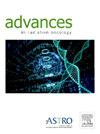采用适度低分割序贯增强的辅助超低分割全乳放射治疗的耐受性:一项单一机构分析
IF 2.7
Q3 ONCOLOGY
引用次数: 0
摘要
目的:本研究在一项前瞻性观察队列研究中评估了保乳手术后接受辅助超低分割全乳放射治疗(uhWBRT)的患者的早期和中期治疗耐受性,这些患者有或没有适度低分割顺序增强。本系于2020年3月引进hwbrt的方法和材料。我们分析了436例不需要淋巴照射的乳腺肿瘤患者的数据,包括376例浸润性癌(pT1-pT3)和60例导管原位癌。平均年龄62岁(26-85岁)。急性反应(不良事件通用术语标准v4.03)在放射治疗完成时和2至3周后进行评估。晚期效应和患者报告的结果(正常组织的晚期效应-主观,客观,管理和分析以及哈佛美容)在放射治疗后6个月和此后每年进行评估。规定的uhWBRT剂量为26 Gy,分5次每日服用。338名患者(77.5%)接受了4至5次每日剂量10.0至12.5 Gy的连续增强治疗,而98名患者(22.5%)没有接受增强治疗。结果0、1、2级急性毒性分别为29.8%、59.9%、10.3%;2 ~ 3周急性毒性分别为52.1%、40.8%、7.2%。在6个月、1年、2年、3年和4年时,有5.3%、2.0%、1.8%、1.1%和0%的患者发现了2级晚期效应,有1.5%、2.3%、0.9%、0%和0%的患者发现了3级晚期效应。97.7%的患者报告的美容结果被评为良好或优秀。平均随访18个月(中位14个月,范围0-48个月),发现1例局部失败,2例淋巴结失败,9例远处复发。报告了3例死亡,均与肿瘤无关。结论早期和中期结果表明,包括适度低分割强化在内的治疗方案是安全且耐受性良好的,急性毒性率与FAST-Forward试验相当。尽管我们的研究随访时间相对较短,但我们的研究结果表明,uhWBRT,无论是否有适度的低分割增强,都是安全且耐受性良好的。本文章由计算机程序翻译,如有差异,请以英文原文为准。
Tolerance of Adjuvant Ultrahypofractionated Whole-Breast Radiation Therapy Employing Moderately Hypofractionated Sequential Boost: A Single Institution Analysis
Purpose
This analysis evaluates early and intermediate treatment tolerance in a prospective observational cohort study of patients who underwent adjuvant ultrahypofractionated whole-breast radiation therapy (uhWBRT), with or without moderately hypofractionated sequential boost, following breast-conserving surgery.
Methods and Materials
uhWBRT was introduced in our department in March 2020. Data from 436 patients with breast tumors not requiring lymphatic irradiation were analyzed, including 376 with invasive carcinomas (pT1-pT3) and 60 with ductal carcinoma in situ. The mean age was 62 years (range, 26-85). Acute reactions (Common Terminology Criteria for Adverse Events v4.03) were assessed at radiation therapy completion and after 2 to 3 weeks. Late effects and patient-reported outcomes (Late Effects in Normal Tissues–Subjective, Objective, Management and Analytic and Harvard for Cosmesis) were evaluated at 6 months after radiation therapy and annually thereafter. The prescribed uhWBRT dose was 26 Gy in 5 daily fractions. A sequential boost of 10.0 to 12.5 Gy in 4 to 5 daily fractions was administered to 338 patients (77.5%), while 98 (22.5%) did not receive a boost.
Results
Acute toxicity grades 0, 1, and 2 were observed in 29.8%, 59.9%, and 10.3% of patients, respectively, at radiation therapy completion and 52.1%, 40.8%, and 7.2% of patients at 2 to 3 weeks after radiation therapy. Grade 2 late effects were identified in 5.3%, 2.0%, 1.8%, 1.1%, and 0%, and grade 3 late effects were identified in 1.5%, 2.3%, 0.9%, 0%, and 0% of patients at 6 months, 1 years, 2 years, 3 years, and 4 years. Patient-reported outcomes for cosmesis were rated as good or excellent in 97.7% of patients. After a mean follow-up of 18 months (median 14, range, 0-48), 1 local failure, 2 nodal failures, and 9 distant relapses were detected. Three deaths were reported, all nontumor-related.
Conclusions
Early and intermediate results indicate that the treatment schedules, including the moderately hypofractionated boost, are safe and well tolerated, with acute toxicity rates comparable to those in the FAST-Forward trial. Although our study follow up is relatively short, our findings indicate that uhWBRT, with or without a moderately hypofractionated boost, is safe and well tolerated.
求助全文
通过发布文献求助,成功后即可免费获取论文全文。
去求助
来源期刊

Advances in Radiation Oncology
Medicine-Radiology, Nuclear Medicine and Imaging
CiteScore
4.60
自引率
4.30%
发文量
208
审稿时长
98 days
期刊介绍:
The purpose of Advances is to provide information for clinicians who use radiation therapy by publishing: Clinical trial reports and reanalyses. Basic science original reports. Manuscripts examining health services research, comparative and cost effectiveness research, and systematic reviews. Case reports documenting unusual problems and solutions. High quality multi and single institutional series, as well as other novel retrospective hypothesis generating series. Timely critical reviews on important topics in radiation oncology, such as side effects. Articles reporting the natural history of disease and patterns of failure, particularly as they relate to treatment volume delineation. Articles on safety and quality in radiation therapy. Essays on clinical experience. Articles on practice transformation in radiation oncology, in particular: Aspects of health policy that may impact the future practice of radiation oncology. How information technology, such as data analytics and systems innovations, will change radiation oncology practice. Articles on imaging as they relate to radiation therapy treatment.
 求助内容:
求助内容: 应助结果提醒方式:
应助结果提醒方式:


